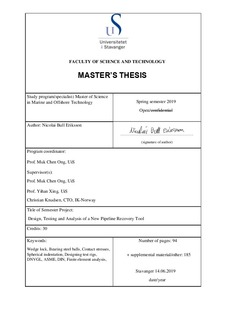| dc.description.abstract | Pipeline Recovery Tools (PRT’s) are used in decommissioning and recovery of subsea pipelines. The PRT often use a mechanical system to insert and lock itself onto the subsea pipeline. This thesis examines a unique connection system that uses steel balls casted within polyurethane. The steel balls provide a wedge-lock mechanism that is locked onto the subsea pipeline; and then the subsea pipeline can be retrieved. The locking process creates an indentation on the steel pipeline. The sealing ability of polyurethane will ensure that the water will not pass though the PRT. However, there were not carried out any tests containing polyurethane in this study. The present study investigates how the steel balls interact with the different components in the wedge-lock mechanism. The areas of interest within the investigated PRT, are the contact surfaces between the bearing steel ball and the pipeline, the cone and the set-pipe. The key parameters evaluated in the present study are the angle of the wedge (α), different material properties, the friction coefficient, the indentation from bearing steel balls and the force exerted on the bearing steel balls.
A comprehensive investigation based on analytical, numerical and experimental approaches were performed in this thesis. First, analytical calculation methods of contact stresses in both linear-elastic and elastic-plastic areas, Brinell and Meyers hardness and spherical fully plastic and elastic indentation, were applied and investigated. Second, experimental tests using two test-rigs were performed to obtain the empirical data. The first test rig was designed to obtain the load carrying capacity of the PRT and the resulting indentation at the pipeline. The second test rig was designed to test the sealing properties. The test rigs are designed according to ASME and DIN standards of a 4-inch pipe. Furthermore, six cones alloyed with Calmax were manufactured. These cones have angles of 3, 4, 5, 6, 8 and 10 degrees. The cones alloyed with Calmax, that were empirically tested, had angles of 3, 4 and 10 degrees. In addition, one 34CrNiMo6 alloyed cone with an angle of 5 degrees was machined and tested. Third, finite element model in ANSYS with detailed contact modelling was built to perform sensitivity studies on friction coefficients and material properties. The model built in ANSYS, had a cone-angle of 3 degrees. Last, the results from the empirical tests, analytical calculations and finite element analyses were compared in term of spherical indentations, stresses, reaction forces and friction coefficients in both linear-elastic and fully plastic areas.
The deformation occurring on the cone, steel balls and/or pipeline wall was found to depend strongly on the material properties, the friction coefficients, the sizing and the reaction forces between the interacting surfaces. Moreover, if the PRT is not aligned perpendicular to the pipeline, the steel balls will experience an uneven reaction force around the diameter of the pipeline. This leads to an uneven deformation pattern that may affect the lifetime of the PRT main body. The knowledge of the friction coefficient is crucial when predicting the indentation depth in the pipeline. The result from finite element analysis shows that a low friction coefficient will cause in less indentation. Lubrication of the steel balls is one suggestion to maintain a low friction coefficient. Yield stress is also a parameter that strongly affects the indentation. To keep the plastic deformation at a minimum on the cone and at a maximum on the pipeline, the cone must be around 2.5 times the hardness of the steel balls and the steel balls must be around 2.5 times the hardness of the pipeline.
The tests show promising results in terms of the PRT’s lifting capacity. However, the reaction forces acting between the steel balls, the cone and the pipeline are very high with small cone-angles, which will often result in spherical deformations on the cone. An increase in cone-angle will reduce the mean pressure between the cone and the steel balls with a fixed magnitude of force acting on the steel balls, which will decrease the indentation depth. Moreover, this results in if self-locking and onset of plastic deformation are present between the steel balls and pipeline, the angle should be as large as possible.
The results from this thesis contributes to a better understanding of the innovative wedge lock mechanisms used in the studied PRT. The findings can also be applied to other PRT applications that uses a ball and taper wedge-lock mechanism. | nb_NO |
